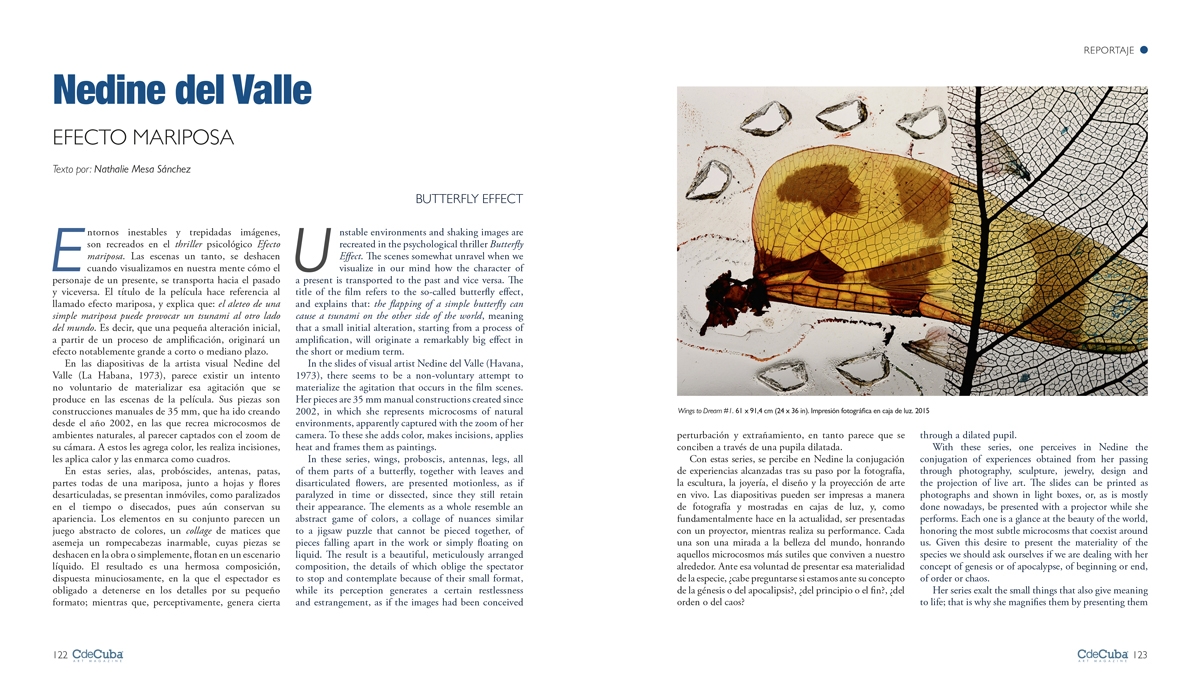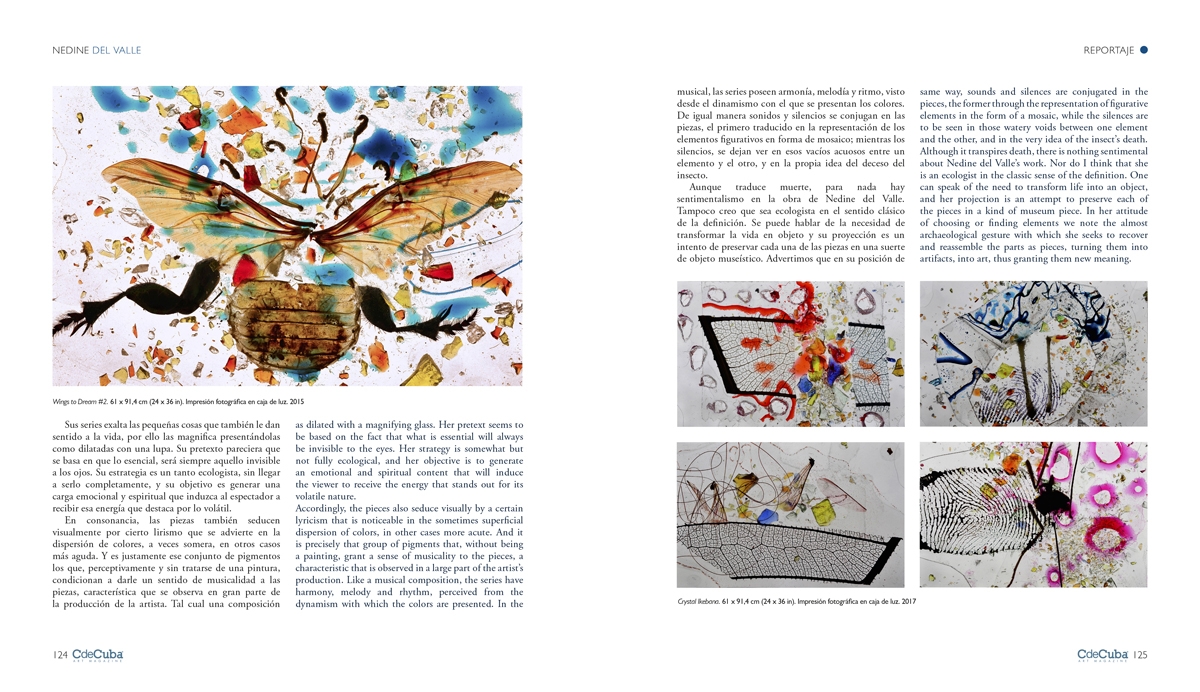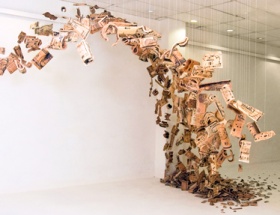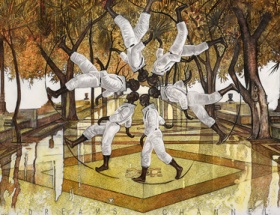Butterfly Effect
By Nathalie Mesa Sánchez
Unstable environments and shaking images are recreated in the psychological thriller Butterfly Effect. The scenes somewhat unravel when we visualize in our mind how the character of a present is transported to the past and vice versa. The title of the film refers to the so-called butterfly effect, and explains that: the flapping of a simple butterfly can cause a tsunami on the other side of the world, meaning that a small initial alteration, starting from a process of amplification, will originate a remarkably big effect in the short or medium term.
In the slides of visual artist Nedine del Valle (Havana, 1973), there seems to be a non-voluntary attempt to materialize the agitation that occurs in the film scenes. Her pieces are 35 mm manual constructions created since 2002, in which she represents microcosms of natural environments, apparently captured with the zoom of her camera. To these she adds color, makes incisions, applies heat and frames them as paintings.
 In these series, wings, proboscis, antennas, legs, all of them parts of a butterfly, together with leaves and disarticulated flowers, are presented motionless, as if paralyzed in time or dissected, since they still retain their appearance. The elements as a whole resemble an abstract game of colors, a collage of nuances similar to a jigsaw puzzle that cannot be pieced together, of pieces falling apart in the work or simply floating on liquid. The result is a beautiful, meticulously arranged composition, the details of which oblige the spectator to stop and contemplate because of their small format, while its perception generates a certain restlessness and estrangement, as if the images had been conceived through a dilated pupil.
In these series, wings, proboscis, antennas, legs, all of them parts of a butterfly, together with leaves and disarticulated flowers, are presented motionless, as if paralyzed in time or dissected, since they still retain their appearance. The elements as a whole resemble an abstract game of colors, a collage of nuances similar to a jigsaw puzzle that cannot be pieced together, of pieces falling apart in the work or simply floating on liquid. The result is a beautiful, meticulously arranged composition, the details of which oblige the spectator to stop and contemplate because of their small format, while its perception generates a certain restlessness and estrangement, as if the images had been conceived through a dilated pupil.
With these series, one perceives in Nedine the conjugation of experiences obtained from her passing through photography, sculpture, jewelry, design and the projection of live art. The slides can be printed as photographs and shown in light boxes, or, as is mostly done nowadays, be presented with a projector while she performs. Each one is a glance at the beauty of the world, honoring the most subtle microcosms that coexist around us. Given this desire to present the materiality of the species we should ask ourselves if we are dealing with her concept of genesis or of apocalypse, of beginning or end, of order or chaos.
Her series exalt the small things that also give meaning to life; that is why she magnifies them by presenting them as dilated with a magnifying glass. Her pretext seems to be based on the fact that what is essential will always be invisible to the eyes. Her strategy is somewhat but not fully ecological, and her objective is to generate an emotional and spiritual content that will induce the viewer to receive the energy that stands out for its volatile nature.
Accordingly, the pieces also seduce visually by a certain lyricism that is noticeable in the sometimes superficial dispersion of colors, in other cases more acute. And it is precisely that group of pigments that, without being a painting, grant a sense of musicality to the pieces, a characteristic that is observed in a large part of the artist’s production. Like a musical composition, the series have harmony, melody and rhythm, perceived from the dynamism with which the colors are presented. In the same way, sounds and silences are conjugated in the pieces, the former through the representation of figurative elements in the form of a mosaic, while the silences are to be seen in those watery voids between one element and the other, and in the very idea of the insect’s death.
 Although it transpires death, there is nothing sentimental about Nedine del Valle’s work. Nor do I think that she is an ecologist in the classic sense of the definition. One can speak of the need to transform life into an object, and her projection is an attempt to preserve each of the pieces in a kind of museum piece. In her attitude of choosing or finding elements we note the almost archaeological gesture with which she seeks to recover and reassemble the parts as pieces, turning them into artifacts, into art, thus granting them new meaning.
Although it transpires death, there is nothing sentimental about Nedine del Valle’s work. Nor do I think that she is an ecologist in the classic sense of the definition. One can speak of the need to transform life into an object, and her projection is an attempt to preserve each of the pieces in a kind of museum piece. In her attitude of choosing or finding elements we note the almost archaeological gesture with which she seeks to recover and reassemble the parts as pieces, turning them into artifacts, into art, thus granting them new meaning.
In my opinion, Nedine is an artist who at times seems obsessive and enveloping, but always motivated by sincerity and the desire to remove the spectator’s psyche with her minimalist gesture, but deep in meaning and sensations. I admit that it is difficult to understand the internal universe she pours into her work, but it is fascinating the way in which, with an inert scream, she drives us the whole time to psychoanalytic processes in which we establish an inexplicable connection with each of the parts of her pieces. It will be worthwhile to continue rediscovering her, because I don’t think this is the only meaning of her imposing work.






